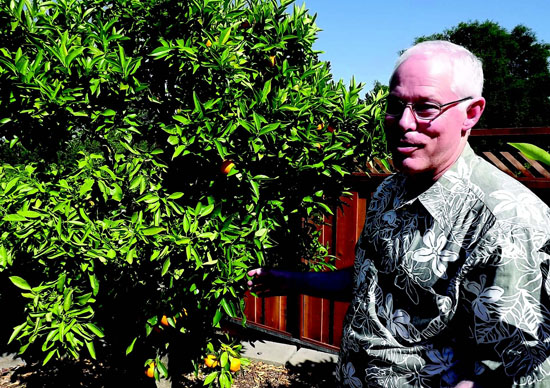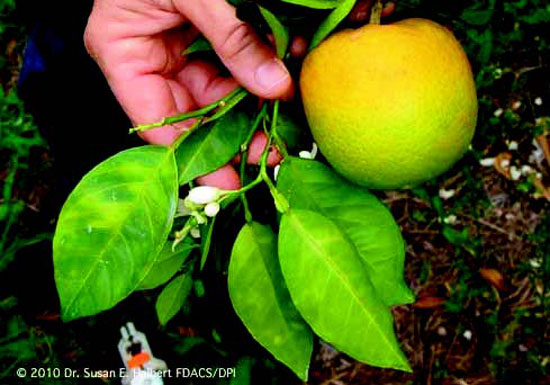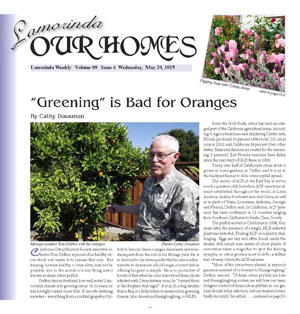|
|
Published May 20th, 2015
|
"Greening" is Bad for Oranges
|
|
| By Cathy Dausman |
 |
| Moraga resident Tom Delfino with his oranges Photos Cathy Dausman |
California Citrus Nursery Society executive director Tom Delfino is proud of his healthy citrus stock and wants it to remain that way. But keeping his trees healthy, or even alive, may not be possible, due to the arrival of a tiny flying insect known as Asian citrus psyllid.
 Delfino knows firsthand how well suited Lamorinda's climate is to growing citrus. In 22 years, he has lovingly coaxed more than 30 mouth-watering varieties - everything from a cocktail grapefruit hybrid to lemons, limes, oranges, mandarins and mandarinquats from the soil in his Moraga yard. He is so devoted to his citrus quality that he uses a refractometer to determine a fruit's sugar content before offering his guest a sample. He is so protective of his stock that when he once discovered three plants infected with Citrus tristeza virus, he "burned them in the fireplace that night." But ACP, a bug smaller than a flea, is a killer when it carries citrus greening disease (also known as Huanglongbing, or HLB).
Delfino knows firsthand how well suited Lamorinda's climate is to growing citrus. In 22 years, he has lovingly coaxed more than 30 mouth-watering varieties - everything from a cocktail grapefruit hybrid to lemons, limes, oranges, mandarins and mandarinquats from the soil in his Moraga yard. He is so devoted to his citrus quality that he uses a refractometer to determine a fruit's sugar content before offering his guest a sample. He is so protective of his stock that when he once discovered three plants infected with Citrus tristeza virus, he "burned them in the fireplace that night." But ACP, a bug smaller than a flea, is a killer when it carries citrus greening disease (also known as Huanglongbing, or HLB).
 Since the Gold Rush, citrus has been an integral part of the California agricultural scene. According to Agricultural Resource Marketing Center data, Florida produced 63 percent of the total U.S. citrus crop in 2012, and California 34 percent (two other states, Texas and Arizona accounted for the remaining 3 percent). But Florida numbers have fallen since the discovery of HLB there in 2005.
Since the Gold Rush, citrus has been an integral part of the California agricultural scene. According to Agricultural Resource Marketing Center data, Florida produced 63 percent of the total U.S. citrus crop in 2012, and California 34 percent (two other states, Texas and Arizona accounted for the remaining 3 percent). But Florida numbers have fallen since the discovery of HLB there in 2005.
 Today over half of California's citrus stock is grown in home gardens, so Delfino said it is up to the backyard farmer to slow citrus psyllid spread.
Today over half of California's citrus stock is grown in home gardens, so Delfino said it is up to the backyard farmer to slow citrus psyllid spread.
 The arrival of ACP in the East Bay is not so much a question of if, but when. ACP insects are already established throughout the world, in Latin America, Arabia, Southeast Asia and China, as well as in parts of Texas, Louisiana, Alabama, Georgia and Florida, Delfino said. In California, ACP presence has been confirmed in 13 counties ranging from Southern California to Santa Clara County.
The arrival of ACP in the East Bay is not so much a question of if, but when. ACP insects are already established throughout the world, in Latin America, Arabia, Southeast Asia and China, as well as in parts of Texas, Louisiana, Alabama, Georgia and Florida, Delfino said. In California, ACP presence has been confirmed in 13 counties ranging from Southern California to Santa Clara County.
 The psyllid arrived in California in 2008; four years later, the presence of a single, HLB-infected plant was detected. Finding ACP on a plant is challenging. Eggs are tiny and often found inside the tender, still-curled new leaves of citrus plants. It sometimes takes a magnifier to spot the feeding nymphs, so citrus growers must look for a telltale trail of waxy tubule the ACP excretes.
The psyllid arrived in California in 2008; four years later, the presence of a single, HLB-infected plant was detected. Finding ACP on a plant is challenging. Eggs are tiny and often found inside the tender, still-curled new leaves of citrus plants. It sometimes takes a magnifier to spot the feeding nymphs, so citrus growers must look for a telltale trail of waxy tubule the ACP excretes.
 "None of the citrus trees planted in anyone's garden is resistant of or tolerant to Huanglongbing," Delfino warned. "If Asian citrus psyllids are here and Huanglongbing arrives, we will lose our trees. Diligent control of Asian citrus psyllids in our gardens should delay infection, but our trees will eventually succumb," he added.
"None of the citrus trees planted in anyone's garden is resistant of or tolerant to Huanglongbing," Delfino warned. "If Asian citrus psyllids are here and Huanglongbing arrives, we will lose our trees. Diligent control of Asian citrus psyllids in our gardens should delay infection, but our trees will eventually succumb," he added.
 Delfino said Lamorindan farmers can fight HLB spread three ways: "Watch out for psyllid (inspect your citrus plants regularly, ideally, every month), use only registered budwood when grafting, and don't move trees outside the quarantine area."
Delfino said Lamorindan farmers can fight HLB spread three ways: "Watch out for psyllid (inspect your citrus plants regularly, ideally, every month), use only registered budwood when grafting, and don't move trees outside the quarantine area."
 It is illegal in California to import citrus fruit or plant material from other states or countries. To inquire about HLB call the California Department of Food and Agriculture exotic pest hotline at 1-800-491-1899, or go online to http://cisr.ucr.edu/asian_citrus_psyllid.html.
It is illegal in California to import citrus fruit or plant material from other states or countries. To inquire about HLB call the California Department of Food and Agriculture exotic pest hotline at 1-800-491-1899, or go online to http://cisr.ucr.edu/asian_citrus_psyllid.html.
 To obtain state approved citrus budwood for graft, go to http://ccpp.ucr.edu/ or http://www.agmrc.org/commodities__products/fruits/citrus/citrus-profile/.
To obtain state approved citrus budwood for graft, go to http://ccpp.ucr.edu/ or http://www.agmrc.org/commodities__products/fruits/citrus/citrus-profile/.

|
 |
| Nymphs and white waxy tubules of Asian citrus psyllid, Diaphorina citri Kuwayama, infesting citrus and being tended by ants. Photo Michael E. Rogers, University of Florida |
 |
| Asymmetrical yellow mottling of leaves and odd shape and greening of fruit, symptoms of Huanglongbing (citrus greening). Photo Dr. Susan E. Halbert |
|
|
|
|
| |
|
|
|
|






